Automated Hyperspectral Feature Selection and Classification of Wildlife Using Uncrewed Aerial Vehicles
Abstract
1. Introduction
- Creation of a spectral library of four mammal species: cow (Bos taurus), horse (Equus caballus), deer (Odocoileus virginianus), and goat (Capra hircus).
- First study to look at the use of HSI collected by a small UAS to classify terrestrial mammalian species.
- Study the efficacy of neural network and deep machine learning models to classify HSI pixels without using any spatial information.
- Simulate 5-band multispectral data from HSI and test classification efficacy.
- An assessment of the technical feasibility of using spectral features for wildlife detection for invasive species and pest management.
2. Materials and Methods
2.1. Materials
2.2. Methods
2.2.1. Dimensionality Reduction
2.2.2. Maximum Likelihood Classification
2.2.3. Artificial Neural Networks and 1D Convolutional Networks
2.2.4. Simulated Multispectral Classification
2.2.5. Model Evaluation
3. Results
3.1. Dimensionality Reduction
3.2. Model Performance
4. Discussion
Author Contributions
Funding
Data Availability Statement
Acknowledgments
Conflicts of Interest
References
- Tershy, B.R.; Shen, K.-W.; Newton, K.M.; Holmes, N.D.; Croll, D.A. The Importance of Islands for the Protection of Biological and Linguistic Diversity. BioScience 2015, 65, 592–597. [Google Scholar] [CrossRef]
- Spatz, D.R.; Holmes, N.D.; Will, D.J.; Hein, S.; Carter, Z.T.; Fewster, R.M.; Keitt, B.; Genovesi, P.; Samaniego, A.; Croll, D.A.; et al. The global contribution of invasive vertebrate eradication as a key island restoration tool. Sci. Rep. 2022, 12, 13391. [Google Scholar] [CrossRef] [PubMed]
- Jones, H.P.; Holmes, N.D.; Butchart, S.H.M.; Tershy, B.R.; Kappes, P.J.; Corkery, I.; Aguirre-Muñoz, A.; Armstrong, D.P.; Bonnaud, E.; Burbidge, A.A.; et al. Invasive mammal eradication on islands results in substantial conservation gains. Proc. Natl. Acad. Sci. USA 2016, 113, 4033–4038. [Google Scholar] [CrossRef] [PubMed]
- Kappes, P.J.; Benkwitt, C.E.; Spatz, D.R.; Wolf, C.A.; Will, D.J.; Holmes, N.D. Do Invasive Mammal Eradications from Islands Support Climate Change Adaptation and Mitigation? Climate 2021, 9, 172. [Google Scholar] [CrossRef]
- de Wit, L.A.; Zilliacus, K.M.; Quadri, P.; Will, D.; Grima, N.; Spatz, D.; Holmes, N.; Tershy, B.; Howald, G.R.; A Croll, D. Invasive vertebrate eradications on islands as a tool for implementing global Sustainable Development Goals. Environ. Conserv. 2020, 47, 139–148. [Google Scholar] [CrossRef]
- Sandin, S.A.; Becker, P.A.; Becker, C.; Brown, K.; Erazo, N.G.; Figuerola, C.; Fisher, R.N.; Friedlander, A.M.; Fukami, T.; Graham, N.A.J.; et al. Harnessing island–ocean connections to maximize marine benefits of island conservation. Proc. Natl. Acad. Sci. USA 2022, 119, e2122354119. [Google Scholar] [CrossRef]
- Rodrigues, A.S.L.; Brooks, T.M.; Butchart, S.H.M.; Chanson, J.; Cox, N.; Hoffmann, M.; Stuart, S.N. Spatially Explicit Trends in the Global Conservation Status of Vertebrates. PLoS ONE 2014, 9, e113934. [Google Scholar] [CrossRef] [PubMed]
- Fricke, R.M.; Olden, J.D. Technological innovations enhance invasive species management in the anthropocene. BioScience 2023, 73, 261–279. [Google Scholar] [CrossRef]
- Campbell, K.J.; Beek, J.; Eason, C.T.; Glen, A.S.; Godwin, J.; Gould, F.; Holmes, N.D.; Howald, G.R.; Madden, F.M.; Ponder, J.B.; et al. The next generation of rodent eradications: Innovative technologies and tools to improve species specificity and increase their feasibility on islands. Biol. Conserv. 2015, 185, 47–58. [Google Scholar] [CrossRef]
- Martinez, B.; Reaser, J.K.; Dehgan, A.; Zamft, B.; Baisch, D.; McCormick, C.; Giordano, A.J.; Aicher, R.; Selbe, S. Technology innovation: Advancing capacities for the early detection of and rapid response to invasive species. Biol. Invasions 2019, 22, 75–100. [Google Scholar] [CrossRef]
- Campbell, K.J.; Harper, G.; Algar, D.; Hanson, C.C.; Keitt, B.S.; Robinson, S. Review of feral cat eradications on islands. Isl. Invasives Erad. Manag. 2011, 37, 46. [Google Scholar]
- Carrion, V.; Donlan, C.J.; Campbell, K.J.; Lavoie, C.; Cruz, F. Archipelago-Wide Island Restoration in the Galápagos Islands: Reducing Costs of Invasive Mammal Eradication Programs and Reinvasion Risk. PLoS ONE 2011, 6, e18835. [Google Scholar] [CrossRef] [PubMed]
- Anderson, D.P.; Gormley, A.M.; Ramsey, D.S.L.; Nugent, G.; Martin, P.A.J.; Bosson, M.; Livingstone, P.; Byrom, A.E. Bio-economic optimisation of surveillance to confirm broadscale eradications of invasive pests and diseases. Biol. Invasions 2017, 19, 2869–2884. [Google Scholar] [CrossRef]
- Davis, R.A.; Seddon, P.J.; Craig, M.D.; Russell, J.C. A review of methods for detecting rats at low densities, with implications for surveillance. Biol. Invasions 2023, 25, 3773–3791. [Google Scholar] [CrossRef]
- Krishnan, B.S.; Jones, L.R.; Elmore, J.A.; Samiappan, S.; Evans, K.O.; Pfeiffer, M.B.; Blackwell, B.F.; Iglay, R.B. Fusion of visible and thermal images improves automated detection and classification of animals for drone surveys. Sci. Rep. 2023, 13, 10385. [Google Scholar] [CrossRef]
- Schneider, S.; Greenberg, S.; Taylor, G.W.; Kremer, S.C. Three critical factors affecting automated image species recognition performance for camera traps. Ecol. Evol. 2020, 10, 3503–3517. [Google Scholar] [CrossRef]
- Vélez, J.; McShea, W.; Shamon, H.; Castiblanco-Camacho, P.J.; Tabak, M.A.; Chalmers, C.; Fergus, P.; Fieberg, J. An evaluation of platforms for processing camera-trap data using artificial intelligence. Methods Ecol. Evol. 2022, 14, 459–477. [Google Scholar] [CrossRef]
- Morellet, N.; Gaillard, J.; Hewison, A.J.M.; Ballon, P.; Boscardin, Y.; Duncan, P.; Klein, F.; Maillard, D. Indicators of ecological change: New tools for managing populations of large herbivores: Ecological indicators for large herbivore management. J. Appl. Ecol. 2007, 44, 634–643. [Google Scholar] [CrossRef]
- Elmore, J.A.; Schultz, E.A.; Jones, L.R.; Evans, K.O.; Samiappan, S.; Pfeiffer, M.B.; Blackwell, B.F.; Iglay, R.B. Evidence on the efficacy of small unoccupied aircraft systems (UAS) as a survey tool for North American terrestrial, vertebrate animals: A systematic map. Environ. Evid. 2023, 12, 3. [Google Scholar] [CrossRef]
- Joyce, K.E.; Anderson, K.; Bartolo, R.E. Of Course We Fly Unmanned—We’re Women! Drones 2021, 5, 21. [Google Scholar] [CrossRef]
- Lenzi, J.; Barnas, A.F.; ElSaid, A.A.; Desell, T.; Rockwell, R.F.; Ellis-Felege, S.N. Artificial intelligence for automated detection of large mammals creates path to upscale drone surveys. Sci. Rep. 2023, 13, 947. [Google Scholar] [CrossRef]
- Jiménez-Torres, M.; Silva, C.P.; Riquelme, C.; Estay, S.A.; Soto-Gamboa, M. Automatic Recognition of Black-Necked Swan (Cygnus melancoryphus) from Drone Imagery. Drones 2023, 7, 71. [Google Scholar] [CrossRef]
- Zhou, M.; Elmore, J.A.; Samiappan, S.; Evans, K.O.; Pfeiffer, M.B.; Blackwell, B.F.; Iglay, R.B. Improving Animal Monitoring Using Small Unmanned Aircraft Systems (sUAS) and Deep Learning Networks. Sensors 2021, 21, 5697. [Google Scholar] [CrossRef] [PubMed]
- Thomas, C.; Ranchin, T.; Wald, L.; Chanussot, J. Synthesis of Multispectral Images to High Spatial Resolution: A Critical Review of Fusion Methods Based on Remote Sensing Physics. IEEE Trans. Geosci. Remote Sens. 2008, 46, 1301–1312. [Google Scholar] [CrossRef]
- van der Meer, F.D.; van der Werff, H.M.A.; van Ruitenbeek, F.J.A.; Hecker, C.A.; Bakker, W.H.; Noomen, M.F.; van der Meijde, M.; Carranza, E.J.M.; de Smeth, J.B.; Woldai, T. Multi- and hyperspectral geologic remote sensing: A review. Int. J. Appl. Earth Observ. Geoinf. 2012, 14, 112–128. [Google Scholar] [CrossRef]
- Ghiyamat, A.; Shafri, H.Z.M. A review on hyperspectral remote sensing for homogeneous and heterogeneous forest biodiversity assessment. Int. J. Remote. Sens. 2010, 31, 1837–1856. [Google Scholar] [CrossRef]
- Matese, A.; Czarnecki, J.; Samiappan, S.; Moorhead, J. Are unmanned aerial vehicle based hyperspectral imaging and machine learning advancing crop science? Trends Plant Sci. 2023. [Google Scholar] [CrossRef]
- Murphy, P.K.; Kolodner, M.A. Implementation of a Multiscale Bayesian Classification Approach for Hyperspectral Terrain Categorization. Proc. SPIE 2022, 4816, 278–287. [Google Scholar] [CrossRef]
- Camps-Valls, G.; Gómez-Chova, L.; Calpe-Maravilla, J.; Soria-Olivas, E.; Martín-Guerrero, J.D.; Moreno, J. Support Vector Machines for Crop Classification Using Hyperspectral Data. In Proceedings of the 1st Pattern Recognition and Image Analysis, Puerto de Andratx, Mallorca, Spain, 4–6 June 2003; pp. 134–141. [Google Scholar] [CrossRef]
- Chen, Y.; Lin, Z.; Zhao, X.; Wang, G.; Gu, Y. Deep Learning-Based Classification of Hyperspectral Data. IEEE J. Sel. Top. Appl. Earth Obs. Remote Sens. 2014, 7, 2094–2107. [Google Scholar] [CrossRef]
- Goel, P.; Prasher, S.; Patel, R.; Landry, J.; Bonnell, R.; Viau, A. Classification of hyperspectral data by decision trees and artificial neural networks to identify weed stress and nitrogen status of corn. Comput. Electron. Agric. 2003, 39, 67–93. [Google Scholar] [CrossRef]
- Kolmann, M.A.; Kalacska, M.; Lucanus, O.; Sousa, L.; Wainwright, D.; Arroyo-Mora, J.P.; Andrade, M.C. Hyperspectral data as a biodiversity screening tool can differentiate among diverse Neotropical fishes. Sci. Rep. 2021, 11, 16157. [Google Scholar] [CrossRef] [PubMed]
- Krekeler, M.P.S.; Burke, M.; Allen, S.; Sather, B.; Chappell, C.; McLeod, C.L.; Loertscher, C.; Loertscher, S.; Dawson, C.; Brum, J.; et al. A novel hyperspectral remote sensing tool for detecting and analyzing human materials in the environment: A geoenvironmental approach to aid in emergency response. Environ. Earth Sci. 2023, 82, 109. [Google Scholar] [CrossRef]
- Bortolot, Z.J.; Prater, P.E. A first assessment of the use of high spatial resolution hyperspectral imagery in discriminating among animal species, and between animals and their surroundings. Biosyst. Eng. 2009, 102, 379–384. [Google Scholar] [CrossRef]
- Terletzky, P.; Ramsey, R.D.; Neale, C.M.U. Spectral Characteristics of Domestic and Wild Mammals. GIScience Remote Sens. 2012, 49, 597–608. [Google Scholar] [CrossRef]
- Siers, S.R.; Swayze, G.A.; Mackessey, S.P. Spectral analysis reveals limited potential for enhanced-wavelength detection of invasive snakes. Herpetol. Rev. 2013, 44, 56–58. [Google Scholar]
- Chabot, D.; Stapleton, S.; Francis, C.M. Measuring the spectral signature of polar bears from a drone to improve their detection from space. Biol. Conserv. 2019, 237, 125–132. [Google Scholar] [CrossRef]
- Leblanc, G.; Francis, C.M.; Soffer, R.; Kalacska, M.; De Gea, J. Spectral Reflectance of Polar Bear and Other Large Arctic Mammal Pelts; Potential Applications to Remote Sensing Surveys. Remote Sens. 2016, 8, 273. [Google Scholar] [CrossRef]
- Aslett, Z.; Garza, L. Characterization of Domestic Livestock and Associated Agricultural Facilities using NASA/JPL AVIRIS-NG Imaging Spectroscopy Data. In Proceedings of the 2021 11th Workshop on Hyperspectral Imaging and Signal Processing: Evolution in Remote Sensing (WHISPERS), Amsterdam, The Netherlands, 24–26 March 2021; pp. 1–5. [Google Scholar]
- Agrawal, N.; Verma, K. Dimensionality Reduction on Hyperspectral Data Set. In Proceedings of the 2020 First International Conference on Power, Control and Computing Technologies (ICPC2T), Raipur, India, 3–5 January 2020; pp. 139–142. [Google Scholar]
- Lv, W.; Wang, X. Overview of Hyperspectral Image Classification. J. Sens. 2020, 2020, 4817234. [Google Scholar] [CrossRef]
- Duda, R.O.; Hart, P.E.; Stork, D.G. Pattern Classification, 2nd ed.; Wiley: New York, NY, USA, 2001. [Google Scholar]
- Prasad, S.; Bruce, L.M. Limitations of principal components analysis for hyperspectral target recognition. IEEE Geosci. Remote Sens. Lett. 2008, 5, 625–629. [Google Scholar] [CrossRef]
- Pudil, P.; Novovičová, J.; Kittler, J. Floating search methods in feature selection. Pattern Recognit. Lett. 1994, 15, 1119–1125. [Google Scholar] [CrossRef]
- Tharwat, A. Classification assessment methods. Appl. Comput. Inform. 2018, 17, 168–192. [Google Scholar] [CrossRef]
- Cohen, J. A Coefficient of Agreement for Nominal Scales. Educ. Psychol. Meas. 1960, 20, 37–46. [Google Scholar] [CrossRef]
- Landis, J.R.; Koch, G.G. The Measurement of Observer Agreement for Categorical Data. Biometrics 1977, 33, 159–174. [Google Scholar] [CrossRef] [PubMed]
- Colefax, A.P.; Walsh, A.J.; Purcell, C.R.; Butcher, P. Utility of Spectral Filtering to Improve the Reliability of Marine Fauna Detections from Drone-Based Monitoring. Sensors 2023, 23, 9193. [Google Scholar] [CrossRef]

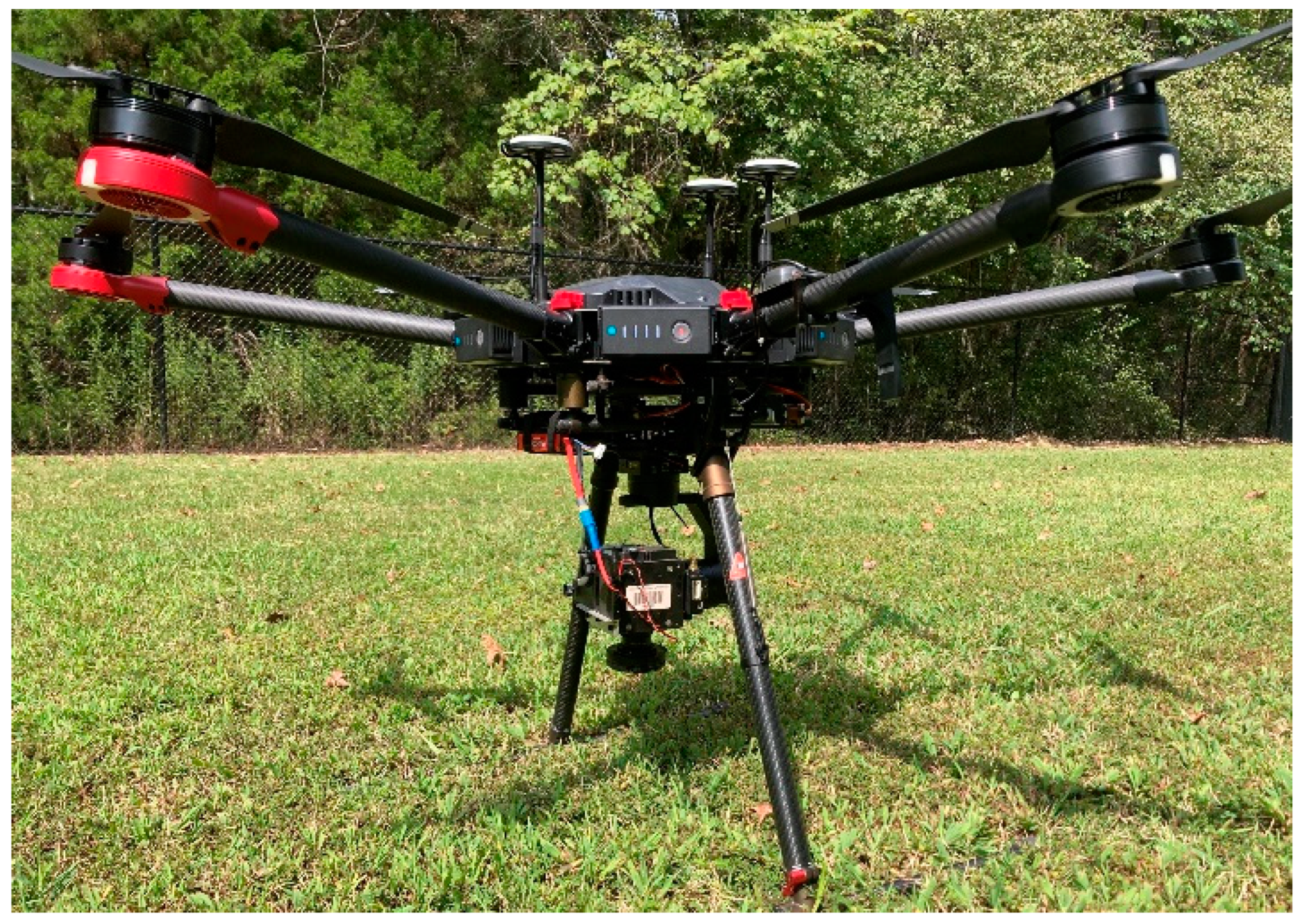
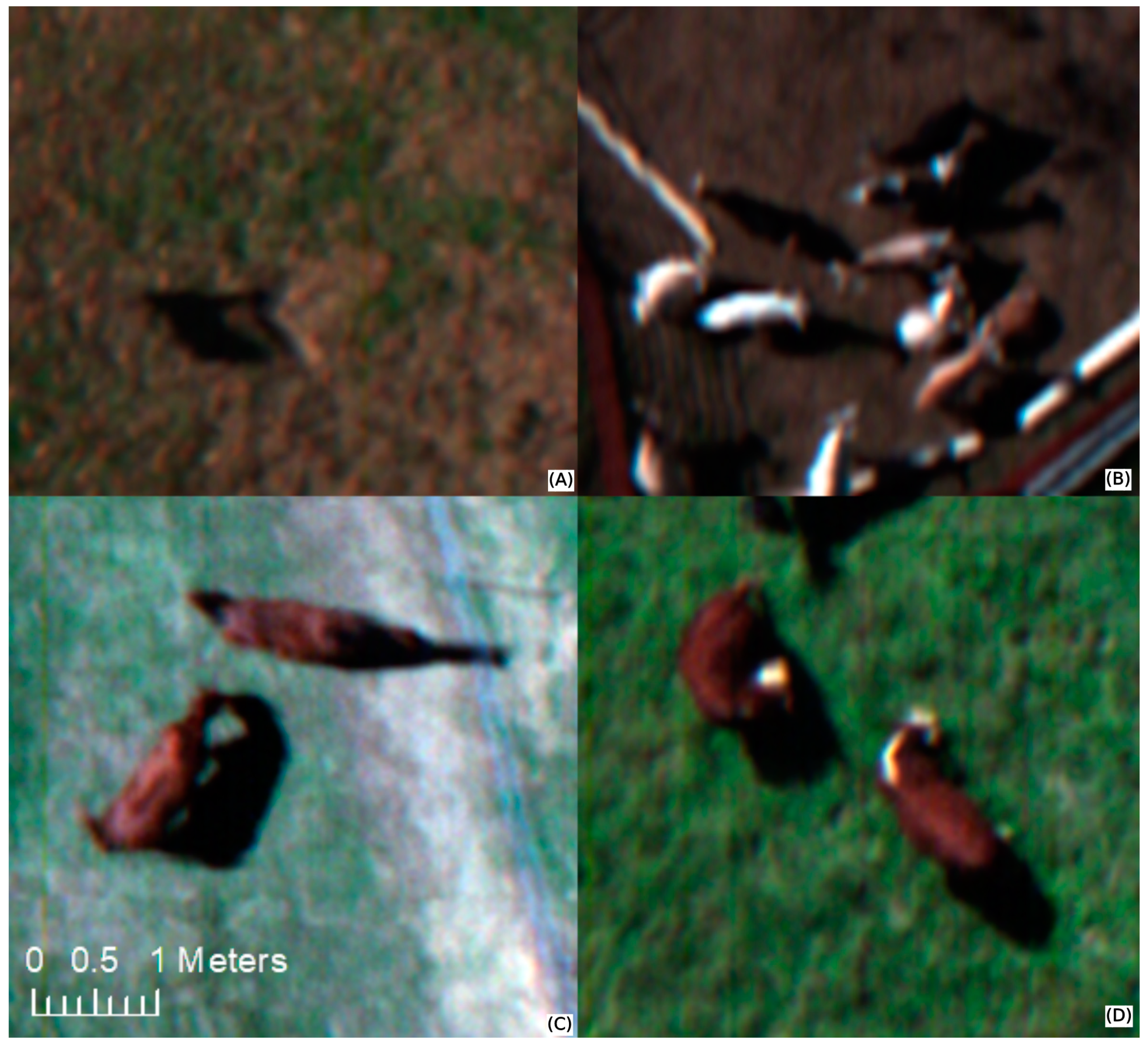

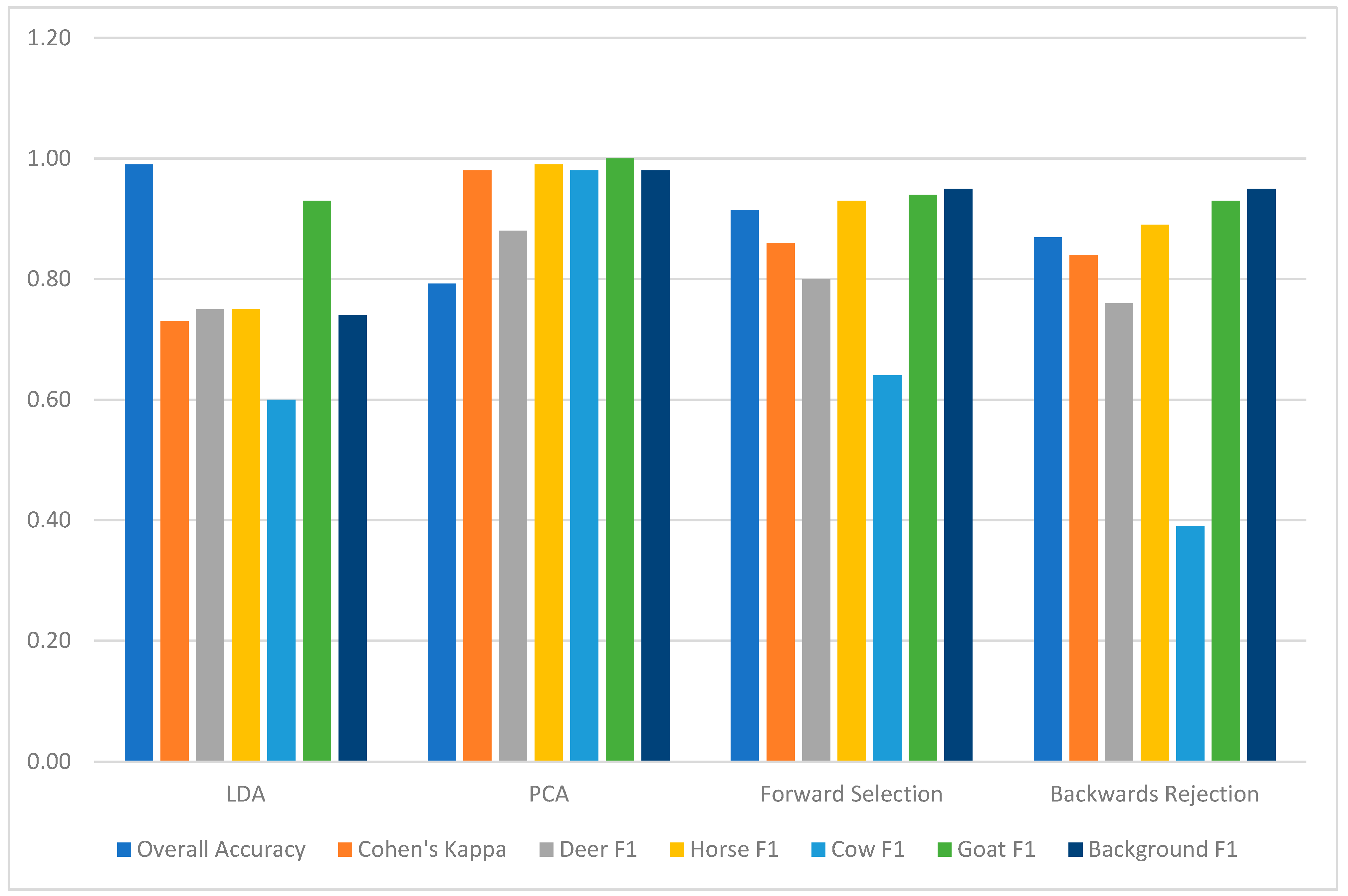
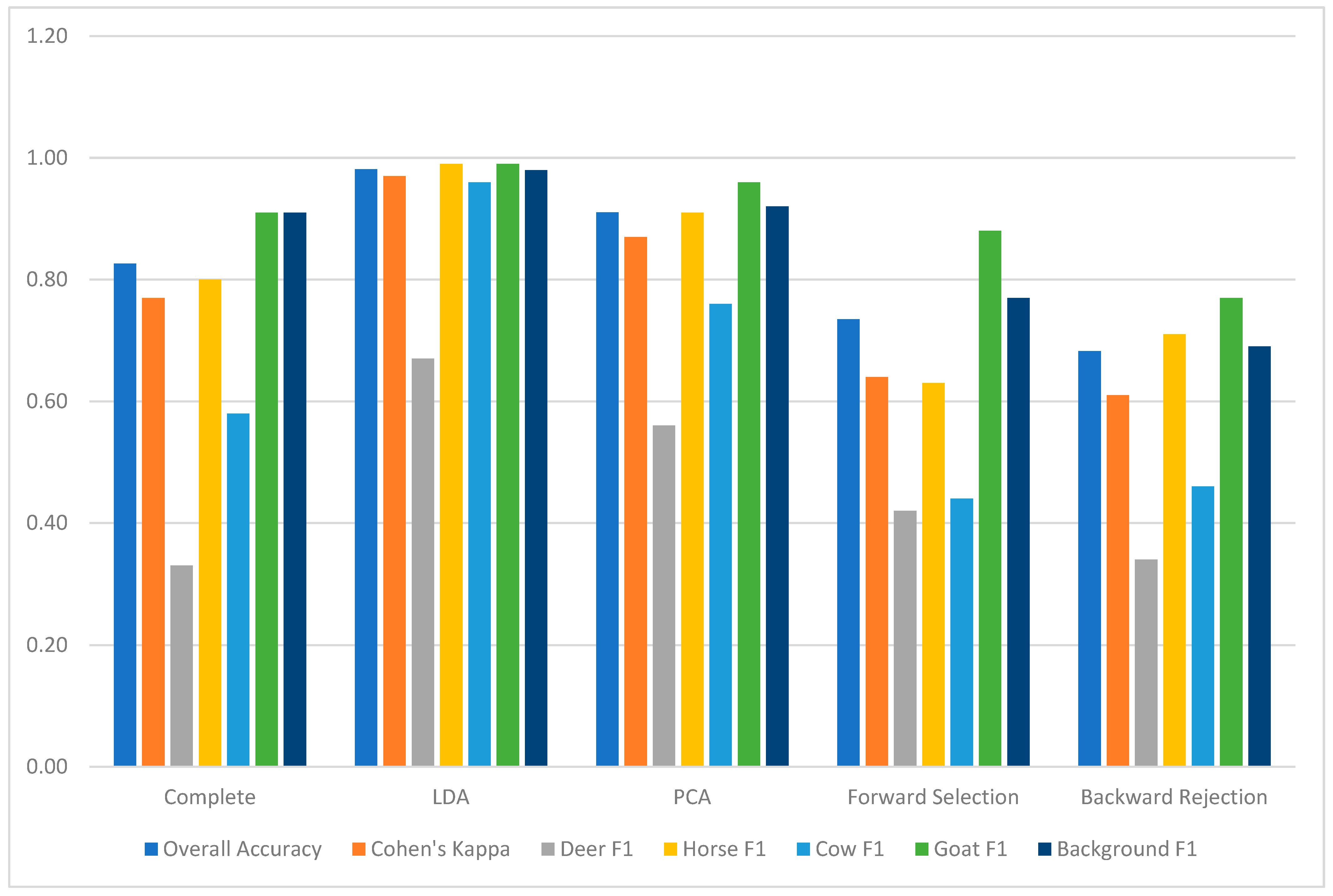

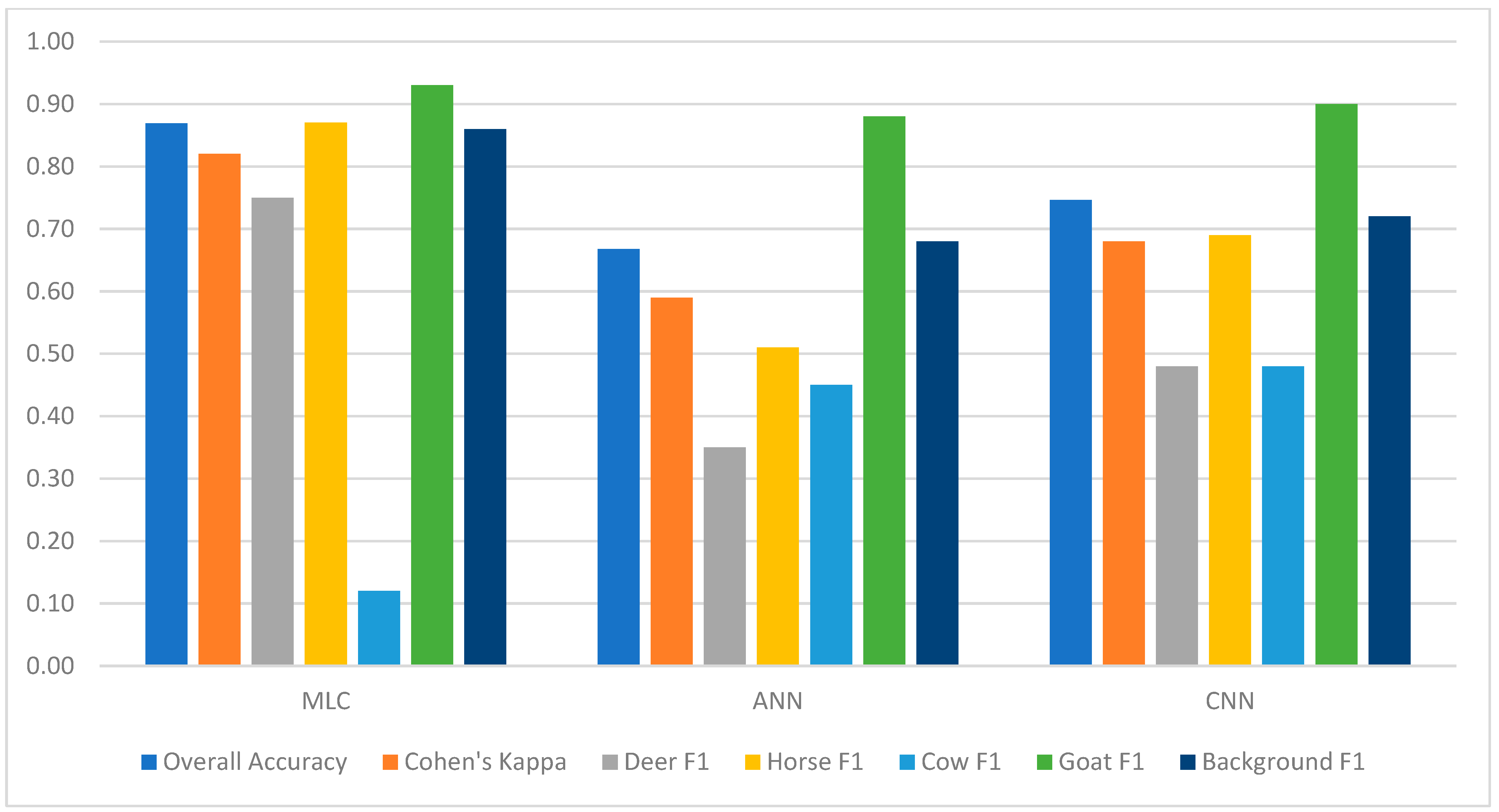
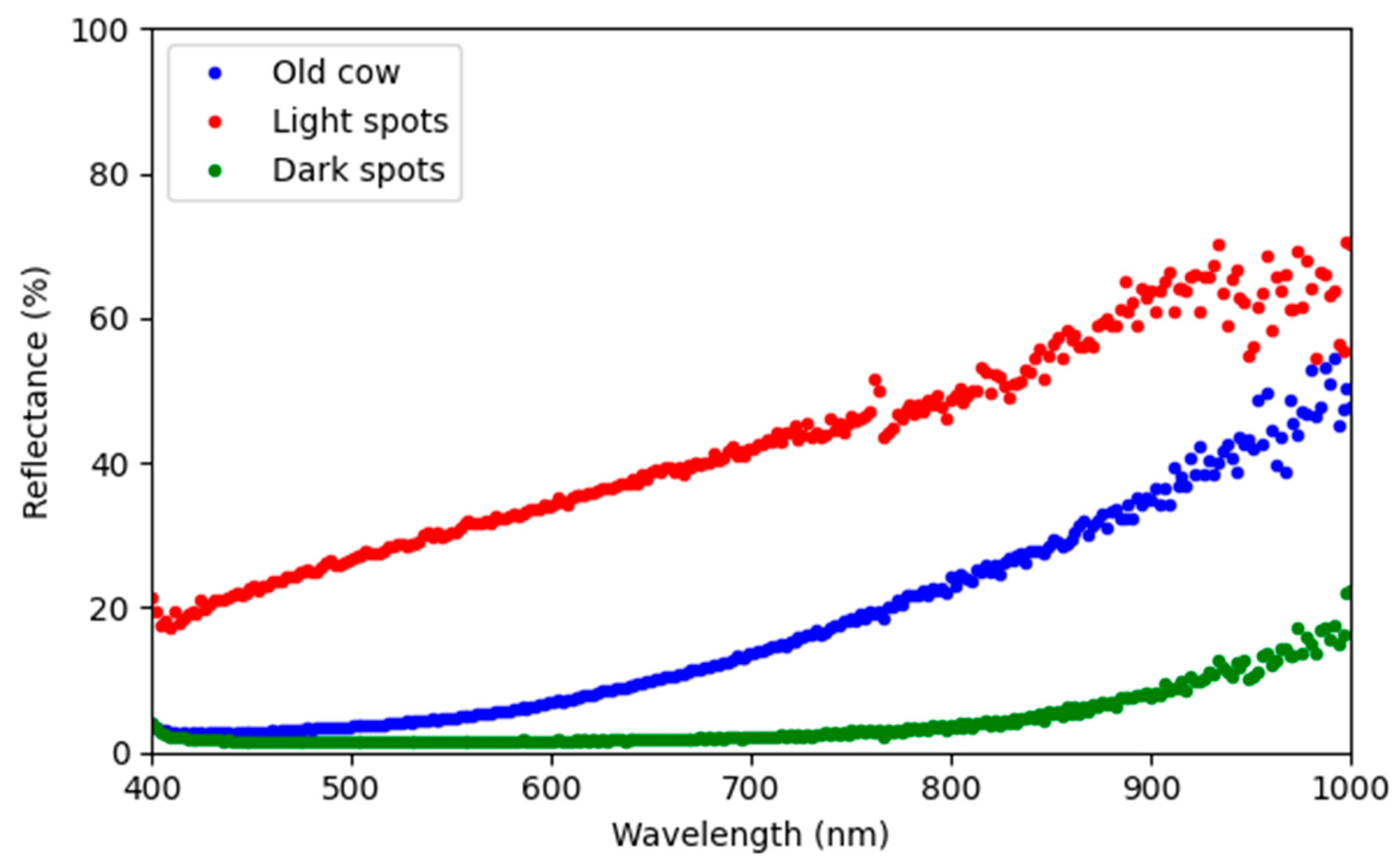
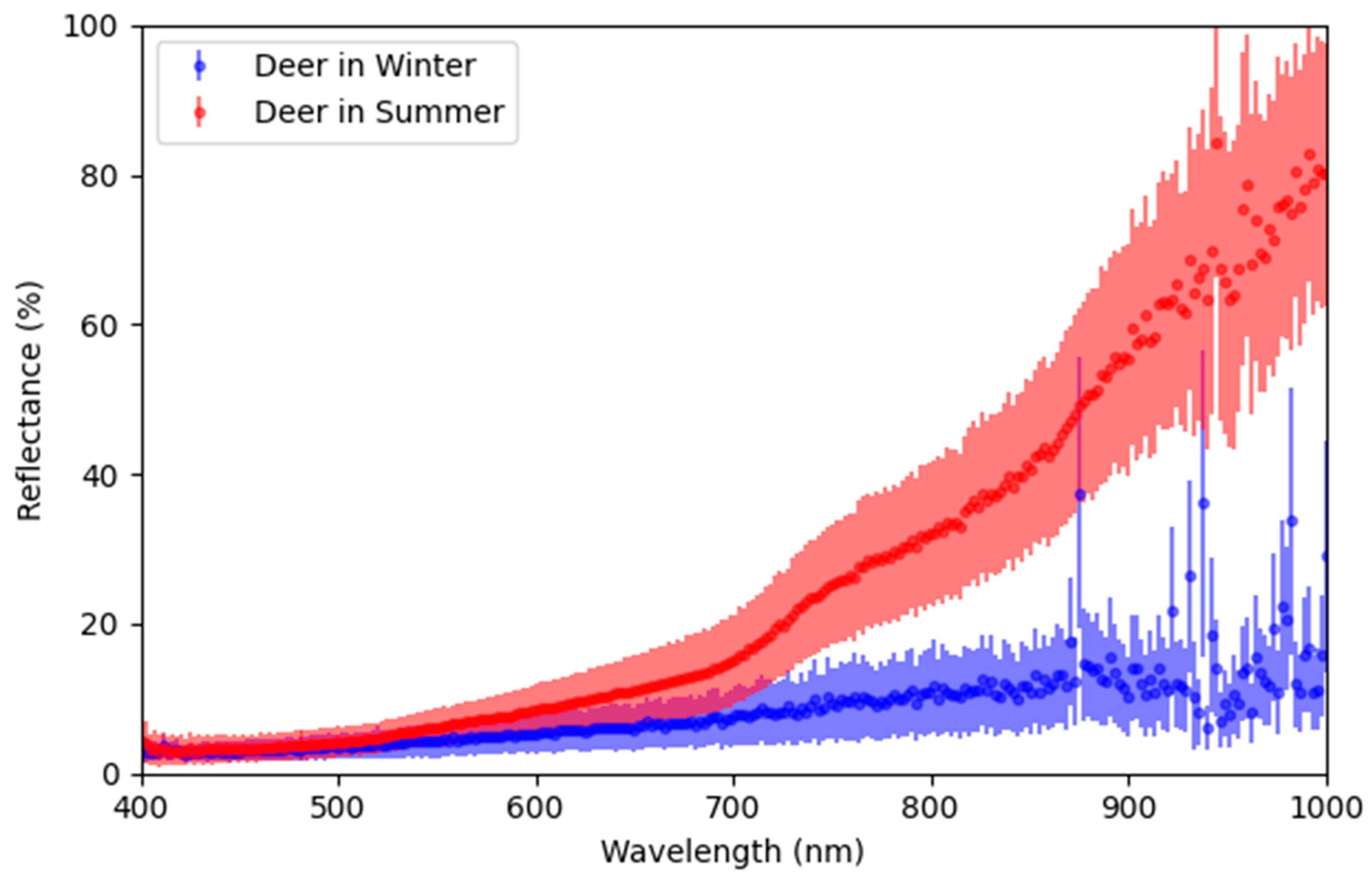
| Deer | Horse | Cow | Goat | Background | |
|---|---|---|---|---|---|
| Number of Animals Collected | 15 | 38 | 30 | 33 | N/A |
| Pure Pixels Sample Size | 219 | 2351 | 703 | 2811 | 2500 |
| Mean Pure Pixel Samples per Animal | 33 | 168 | 117 | 77 | N/A |
| Standard Deviation of Pure Pixel Samples per Animal | 29 | 54 | 29 | 37 | N/A |
| Deer | Horse | Cow | Goat | Background | |
|---|---|---|---|---|---|
| Number of Training Samples | 109 | 109 | 109 | 109 | 109 |
| Number of Testing Samples | 110 | 2242 | 594 | 2702 | 2391 |
| Layer | Layer Name | Output Size | Layer Info | Processing |
|---|---|---|---|---|
| 1 | Input | 1 × 270 * | - | - |
| 2 | Dense | 1 × 20 | - | ReLU |
| 3 | Dense | 1 × 8 | - | ReLU |
| 4 | Dense | 1 × 8 | - | ReLu |
| 5 | Dense | 1 × 4 ** | - | SoftMax |
| 1D Convolutional Network | |||
|---|---|---|---|
| Layer Name | Output Size | Layer Info | Processing |
| Input | 1 × 270 * | - | - |
| Conv1D | 268 × 32 | kernel size = 3 | ReLU |
| MaxPooling1D | 89 × 32 | pool_size = 3 | - |
| Flatten | 1 × 2848 | - | |
| Dense | 1 × 128 | - | ReLu |
| Dense | 1 × 4 ** | - | SoftMax |
Disclaimer/Publisher’s Note: The statements, opinions and data contained in all publications are solely those of the individual author(s) and contributor(s) and not of MDPI and/or the editor(s). MDPI and/or the editor(s) disclaim responsibility for any injury to people or property resulting from any ideas, methods, instructions or products referred to in the content. |
© 2024 by the authors. Licensee MDPI, Basel, Switzerland. This article is an open access article distributed under the terms and conditions of the Creative Commons Attribution (CC BY) license (https://creativecommons.org/licenses/by/4.0/).
Share and Cite
McCraine, D.; Samiappan, S.; Kohler, L.; Sullivan, T.; Will, D.J. Automated Hyperspectral Feature Selection and Classification of Wildlife Using Uncrewed Aerial Vehicles. Remote Sens. 2024, 16, 406. https://doi.org/10.3390/rs16020406
McCraine D, Samiappan S, Kohler L, Sullivan T, Will DJ. Automated Hyperspectral Feature Selection and Classification of Wildlife Using Uncrewed Aerial Vehicles. Remote Sensing. 2024; 16(2):406. https://doi.org/10.3390/rs16020406
Chicago/Turabian StyleMcCraine, Daniel, Sathishkumar Samiappan, Leon Kohler, Timo Sullivan, and David J. Will. 2024. "Automated Hyperspectral Feature Selection and Classification of Wildlife Using Uncrewed Aerial Vehicles" Remote Sensing 16, no. 2: 406. https://doi.org/10.3390/rs16020406
APA StyleMcCraine, D., Samiappan, S., Kohler, L., Sullivan, T., & Will, D. J. (2024). Automated Hyperspectral Feature Selection and Classification of Wildlife Using Uncrewed Aerial Vehicles. Remote Sensing, 16(2), 406. https://doi.org/10.3390/rs16020406








